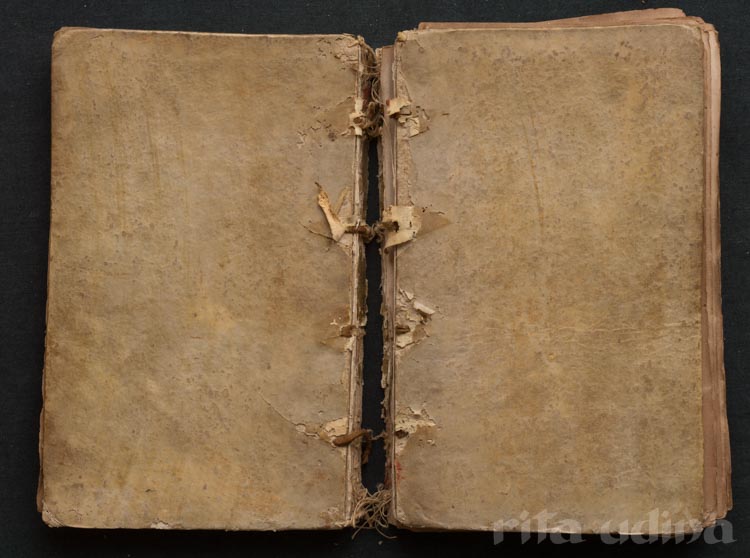Conservation of renaisance astronomy book. A stiff board parchment binding with slotted spine
- Owner: Private collector
- Artefact: Renaissance book about astronomy, by Christopher Clavius. Printed on 1611.
Stiff-board reverse parchment binding with slotted spine. Raised supports sewn on inboard paperboards.
This rare bookbinding structure was produced in northern Italy from 15th to 17th centuries. Inboard bindings over parchment (with stiff boards) were made mirroring those leather ones as a response to the printing appeareance, which entailed reducing costs and shorten time manufacturing of the bindings, accordingly to a much faster textblock production. Parchment was less expensive compared to leather , but also less supple. By slotting the spine the binder could shape the raised supports effortless on a much less malleable support. Under the slots alum tawed leather patches would cover the raised bands. The latter much more flexible and endurant. - Date: 1611.
- Damages: Severe oxidation of the folios, almost full loss of the parchment and leather patches on the spine, detachment of most of the folios due to breakage of the sewing. Tears along the sheets’ edges and folds.
- Conservation treatment: Cleaning and deacidification of the folios. Re-sewn over leather thongs and sewn of new endbands on alum tawed thongs. Reconstruction of the spine supports: reverse parchment with slots and alum tawed leather patches on top of the raised supports.
- Conservartors: Jessica Levy, Crsitina la Chica, Tereza Kubalová, Rita Udina.
- Publication: Udina, Rita. “Conservation of Clavius, a 17th c. printed book bound on parchment stiff boards“. Bachelor´s Degree Final Project, ESCRBCC, 2023.
Clients
AHEH (10)
Alcon-Cusi Pharmacy Museum (5)
Archive Barcelona Sants-Montjuïc Dst. (5)
Archives (51)
Ayuntamiento Barcelona (5)
Barcelona City Council (11)
Barcelona Municipal Archive (9)
Buat Fine Art (3)
CoAC (Association of Architects of Catalonia) (15)
Cores (5)
Documentation Center of Catalan Orfeó (3)
Domènech i Montaner (5)
Gaboche Ars (3)
Galleries (24)
Gazi Husrev-Begova Biblioteka (3)
Government of Catalonia (19)
Historical Archive of Barcelona (3)
Historical Archive of Lleida (4)
ICON (4)
Industrial Museum of Ter (4)
Institute for Cultural Heritage of Spain (IPCE) (6)
INTACH (Dehli) (7)
La Pedrera Foundation (4)
Libraries (30)
Municipal Archive of Renteria (5)
Museums (26)
Márk Somogyi (3)
National Archive of Catalonia (ANC) (8)
National Museum of Norway (4)
NSK - National Library and University (Zagreb CROATIA) (5)
onLine (14)
private collector (27)
Provincial Council of Barcelona (DiBa) (5)
Public Library of Girona Carles Rahola (7)
Regional Archive Baix Ebre (3)
Regional Archive of Vallès Occidental (4)
Regional Archive Urgell (4)
Research Library of Dubrovnik (CROATIA) (4)
Restauratoren Nederland (5)
Rijksmuseum (5)
Sant Cugat del Vallès Council (5)
SICP Chile (3)
Sitges Museums (4)
Tapestry Art Centre Grau Garriga (5)
University of Granada (Spain) (4)
Types of projects
Conservation of renaisance astronomy book. A stiff board parchment binding with slotted spine
- Owner: Private collector
- Artefact: Renaissance book about astronomy, by Christopher Clavius. Printed on 1611.
Stiff-board reverse parchment binding with slotted spine. Raised supports sewn on inboard paperboards.
This rare bookbinding structure was produced in northern Italy from 15th to 17th centuries. Inboard bindings over parchment (with stiff boards) were made mirroring those leather ones as a response to the printing appeareance, which entailed reducing costs and shorten time manufacturing of the bindings, accordingly to a much faster textblock production. Parchment was less expensive compared to leather , but also less supple. By slotting the spine the binder could shape the raised supports effortless on a much less malleable support. Under the slots alum tawed leather patches would cover the raised bands. The latter much more flexible and endurant. - Date: 1611.
- Damages: Severe oxidation of the folios, almost full loss of the parchment and leather patches on the spine, detachment of most of the folios due to breakage of the sewing. Tears along the sheets’ edges and folds.
- Conservation treatment: Cleaning and deacidification of the folios. Re-sewn over leather thongs and sewn of new endbands on alum tawed thongs. Reconstruction of the spine supports: reverse parchment with slots and alum tawed leather patches on top of the raised supports.
- Conservartors: Jessica Levy, Crsitina la Chica, Tereza Kubalová, Rita Udina.
- Publication: Udina, Rita. “Conservation of Clavius, a 17th c. printed book bound on parchment stiff boards“. Bachelor´s Degree Final Project, ESCRBCC, 2023.
Clients
AHEH (10)
Alcon-Cusi Pharmacy Museum (5)
Archive Barcelona Sants-Montjuïc Dst. (5)
Archives (51)
Ayuntamiento Barcelona (5)
Barcelona City Council (11)
Barcelona Municipal Archive (9)
Buat Fine Art (3)
CoAC (Association of Architects of Catalonia) (15)
Cores (5)
Documentation Center of Catalan Orfeó (3)
Domènech i Montaner (5)
Gaboche Ars (3)
Galleries (24)
Gazi Husrev-Begova Biblioteka (3)
Government of Catalonia (19)
Historical Archive of Barcelona (3)
Historical Archive of Lleida (4)
ICON (4)
Industrial Museum of Ter (4)
Institute for Cultural Heritage of Spain (IPCE) (6)
INTACH (Dehli) (7)
La Pedrera Foundation (4)
Libraries (30)
Municipal Archive of Renteria (5)
Museums (26)
Márk Somogyi (3)
National Archive of Catalonia (ANC) (8)
National Museum of Norway (4)
NSK - National Library and University (Zagreb CROATIA) (5)
onLine (14)
private collector (27)
Provincial Council of Barcelona (DiBa) (5)
Public Library of Girona Carles Rahola (7)
Regional Archive Baix Ebre (3)
Regional Archive of Vallès Occidental (4)
Regional Archive Urgell (4)
Research Library of Dubrovnik (CROATIA) (4)
Restauratoren Nederland (5)
Rijksmuseum (5)
Sant Cugat del Vallès Council (5)
SICP Chile (3)
Sitges Museums (4)
Tapestry Art Centre Grau Garriga (5)
University of Granada (Spain) (4)
















